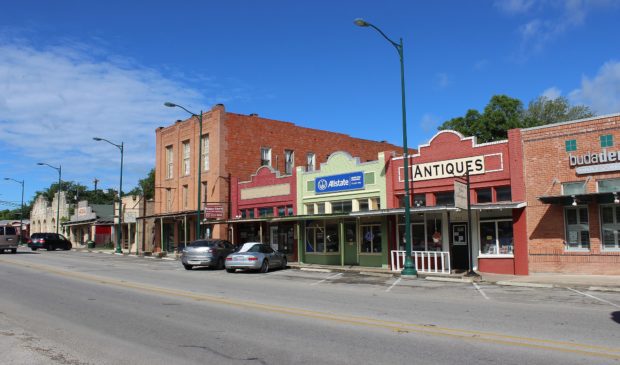Buda seeks passage of aquifer storage bill
Thursday, February 14, 2019 by
Jo Clifton Buda’s explosive growth, from about 7,300 people in 2010 to nearly 17,000 today, coupled with a changing climate that brings both floods and drought, means that the city has to carefully manage its water resources.
The city is hoping to move forward this year with plans for aquifer storage and recovery, so it can store water during the rainy season and retrieve it during times of drought. But because of the unusual configuration of its plan, and the way the Texas Commission on Environmental Quality rules for water storage are written, Buda needs a little help from the Legislature.
New state Rep. Erin Zwiener, D-Driftwood, joined Sen. Donna Campbell, R-New Braunfels, in sponsoring legislation that would allow Buda to store water from the Barton Springs portion of the Edwards Aquifer as well as surface water from the Guadalupe-Brazos River Authority in a well to be drilled into the Trinity Aquifer.
The Trinity Aquifer lies beneath the Edwards. Buda proposes to drill through the Edwards and into the Trinity, casing off the Edwards formation so there would be no mingling with the Edwards water that is already underground. Water would be pumped into the Trinity when it is plentiful, and retrieved during the summer months when water is scarce and demand is at its peak. Buda uses roughly equal amounts of water from the aquifer and the GBRA, according to Buda spokesman David Marino.
Campbell told the Austin Monitor via email, “Aquifer storage and recovery is the future of water conservation. I am working diligently with Central Texas cities to encourage more storage and recovery of groundwater as the state faces increased population growth. A lot of the language in this bill was negotiated last session, and I am hopeful we can get it passed to better serve the needs of families and businesses in the Buda area.”
Only 1,211 bills passed in 2017, out of the more than 6,600 bills that were filed. One of those that died at the end of the session was identical to this session’s Senate Bill 483/House Bill 1044. It would have given Buda a chance to move forward with aquifer storage and recovery, commonly called ASR.
Zwiener said, “This bill gives Buda the tools and resources to reduce their reliance on groundwater. Aquifer storage and recovery is an innovative technology that will allow Buda to store water in times of plenty, so that they can be more resilient in times of drought.”
There are three major facilities for aquifer storage and recovery in Texas – in San Antonio, Kerrville and El Paso. But there are many others around the country, including the largest in the desert city of Las Vegas.
Alicia Reinmund-Martinez, general manager of the Barton Springs/Edwards Aquifer Conservation District, explained why legislation is needed: “Because of the Edwards Aquifer rules … you can only pump Edwards aquifer water through the Edwards formation. So, this piece of legislation will allow Buda to pump other water into their storage well – as long as they treat to water quality standards that are comparable to public drinking water standards that are established by TCEQ.”
That ensures that the water they are injecting into the well is high-quality water, she said, adding, “The bottom line is all aquifer storage and recovery is going to lessen the demand they will have on the Edwards Aquifer during times of drought.”
Blake Neffendorf, Buda’s water resources coordinator, said Buda has been studying the aquifer storage question since 2015. In 2016, the city hired engineering firm CH2M to do a feasibility study and the city is ready to drill a test well once it gets permission from TCEQ. After that is done, if the legislation wins approval, Buda will be ready to move forward with ASR.
Neffendorf said, “Part of the process is we will inject a couple different amounts of volume into the well and test the water quality and see other parameters associated with the aquifer.” Buda’s use varies but is about 450 million gallons per year, roughly split between Edwards Aquifer and GBRA water. But in times of drought, Neffendorf said, the aquifer district can cut Buda’s supply.
Craig Smith, who sits on the board of the Barton Springs/Edwards Aquifer Conservation District, said, “In this era of climate change, the predictions are there would be both more frequent and severe droughts and more flood events … so it only makes sense that we would capture some of that surplus water and store it for when we need it in a drought. Aquifer storage has big advantages over surface reservoirs. First, you don’t have to buy the land, you can store it in the ground … and there’s no evaporation, which from a surface reservoir in the summertime is a terrific amount. So I think it’s a sensible response to climate change.”
Photo by Travis K. Witt [CC BY-SA 4.0], from Wikimedia Commons.
The Austin Monitor’s work is made possible by donations from the community. Though our reporting covers donors from time to time, we are careful to keep business and editorial efforts separate while maintaining transparency. A complete list of donors is available here, and our code of ethics is explained here.
You're a community leader
And we’re honored you look to us for serious, in-depth news. You know a strong community needs local and dedicated watchdog reporting. We’re here for you and that won’t change. Now will you take the powerful next step and support our nonprofit news organization?







